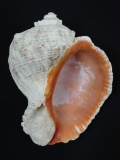Dive Card Identifies Invaders
|
A waterproof identification card featuring several known or likely invasive species in Tampa Bay is being offered to divers, fishermen and others who want to serve as "Eyes On The Bay."
The laminated dive card provides photos and basic information about eight invasive species that already are found in Tampa Bay and other Florida waters, or are likely to arrive here in the near future. Existing invaders include the Asian green mussel and the Australian spotted jellyfish. Potential invaders include Chinese mitten crab and Caulerpa taxifolia, a toxic species of algae.
Non-native plants and animals released into Florida's environment cause millions of dollars in damage each year. Economic costs include clogged water intake pipes and machinery, and fouled boat hulls and propellers. Environmental impacts include a dramatic loss of bio-diversity as the invaders (with no natural predators in their new home) outcompete more beneficial native plants and wildlife.
The dive card asks those who are in or on the water frequently to look out for the listed species, and to report sightings to an 800 number or a website maintained by the U.S. Geological Survey. Timely reporting of sightings is important both to track the spread of existing invasive plants and animals, and to prevent the spread of new intruders.
The card was developed by the Tampa Bay Estuary Program as part of its "Eyes On The Bay" program, with assistance from Florida Sea Grant and the University of Central Florida. To obtain your dive card, contact Nanette Holland at (727) 893-2765 or e-mail nanette@tbep.org.
|

The veined rapa whelk (Rapana venos) is a likely invader not yet seen in Tampa Bay. Native to Asia and now present in the Chesapeake Bay, adult whelks can grow to seven inches and are able to consume large numbers of native oysters.
|

 |
Mini-Grant Applications Due 10/1
Community groups involved in environmental restoration and education projects that may qualify for up to $7,500 in Bay Mini-Grants must complete applications by Oct. 1, 2003. The Mini-Grant funding - estimated at more than $100,000 for 2003-2004 -comes from the sale of Tampa Bay Estuary license plates, also known as "tarpon tags." Left, volunteers help install 125 artificial oyster reef balls last year along Bayshore Boulevard to reduce the wave energy and allow further restoration of the shoreline. For more information and a grant application, visit the Tampa Bay Estuary Program at www.tbep.org.
|

Davis Tract Restoration Wins Community Design Award
60-acre landfill restored to natural uplands with native plantings and 10 acres of wetlands has won an Award of Merit from the Hillsborough County Planning Commission. Part of the Davis Tract, adjacent to "The Kitchen" section of Tampa Bay, it was the first component of a 232-acre restoration effort.
An innovative wetlands restoration project transformed a borrow pit, roadway and rim ditches into viable, productive open water and marshes with an intertidal open water lagoon. Williams Street, once a crime-ridden road, is now a series of tidal channels, coves, marshes and islands. More than 3500 native plants were spread across the 50-acre uplands, with recycled mulch used to reduce the growth of non-native and nuisance plants.
Purchased by the Hillsborough County Environmental Lands Acquisition and Protection Program in 1997, he Davis Tract restoration is a joint effort of the Surface Water Improvement and Management (SWIM) Program of the Southwest Florida Water Management District and the Hillsborough County Resource Management Section with support from Tampa BayWatch, National Audubon Society, Concerned Citizens of Gibsonton and Consolidated Resource Recovery. The site is now managed as a green space nature park by Hillsborough County.

Fin Clips ID Hatchery Fish
Two redfish caught by recreational anglers have been identified as hatchlings raised at the state's Stock Enhancement Research Facility in Port Manatee. Initially released as fingerlings (4 inches long and 1 inch long) in 2002, the fish were identified by a genetic process that uses a small portion of their fin.
Since 1988, the Florida Fish and Wildlife Conservation Commission's Florida Marine Research Institute hatchery has raised and released more than 4.7 million redfish. More than 2.5 million redfish have been released as part of Project Tampa Bay, a pilot study designed to determine the effectiveness of stocking hatchery-raised fish. "This shows that we can release fish as small as an inch and have them grow to legal size," says Gina Russo, outreach coordinator for the hatchery.

Tampa Bay is getting better.
You can help.
Buy a Tampa Bay Estuary tag and help keep Tampa Bay on the road to recovery. They're available year-round in your local tax collector's office or request a Tampa Bay Estuary tag with your annual renewal.
The cost is $27 for the first year and $17 after that - with $15 going directly to projects that benefit the estuary, including the publication of Bay Soundings.
|
 |
|



